Abstract
We examined the potential impacts of climate variability and change on human health as part of a congressionally mandated study of climate change in the United States. Our author team, comprising experts from academia, government, and the private sector, was selected by the federal interagency U.S. Global Change Research Program, and this report stems from our first 18 months of work. For this assessment we used a set of assumptions and/or projections of future climates developed for all participants in the National Assessment of the Potential Consequences of Climate Variability and Change. We identified five categories of health outcomes that are most likely to be affected by climate change because they are associated with weather and/or climate variables: temperature-related morbidity and mortality; health effects of extreme weather events (storms, tornadoes, hurricanes, and precipitation extremes); air-pollution-related health effects; water- and foodborne diseases; and vector- and rodent-borne diseases. We concluded that the levels of uncertainty preclude any definitive statement on the direction of potential future change for each of these health outcomes, although we developed some hypotheses. Although we mainly addressed adverse health outcomes, we identified some positive health outcomes, notably reduced cold-weather mortality, which has not been extensively examined. We found that at present most of the U.S. population is protected against adverse health outcomes associated with weather and/or climate, although certain demographic and geographic populations are at increased risk. We concluded that vigilance in the maintenance and improvement of public health systems and their responsiveness to changing climate conditions and to identified vulnerable subpopulations should help to protect the U.S. population from any adverse health outcomes of projected climate change.
Full text
PDF


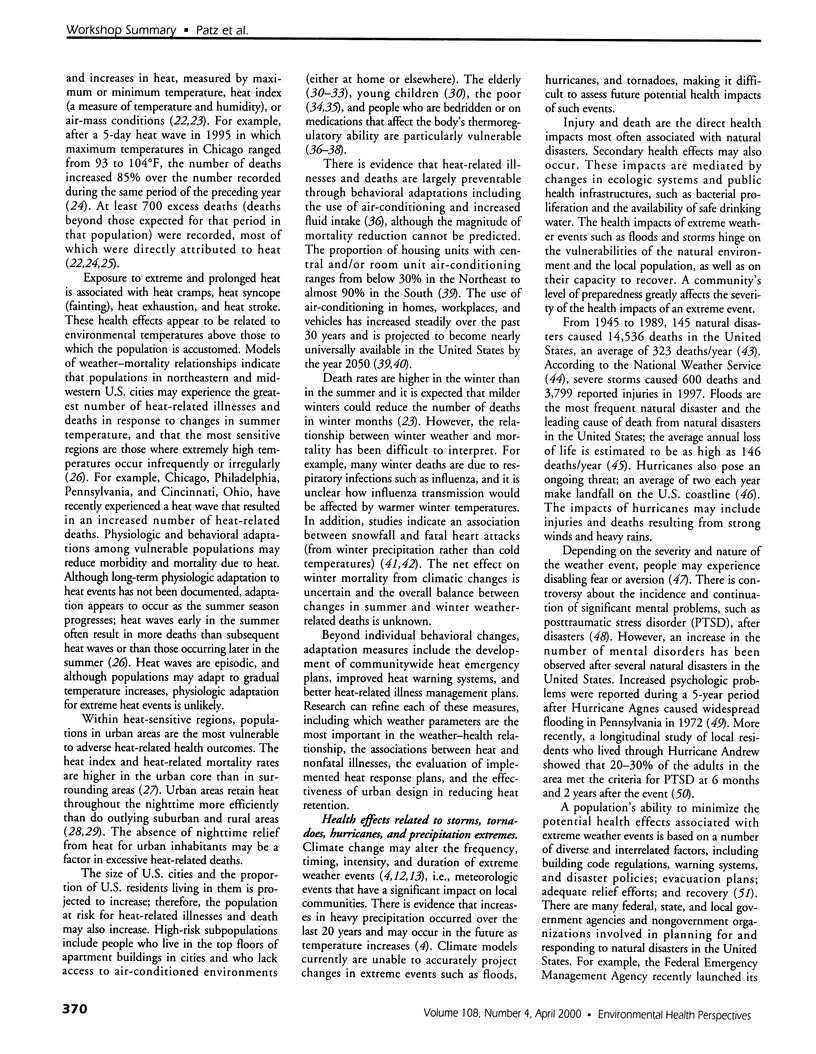

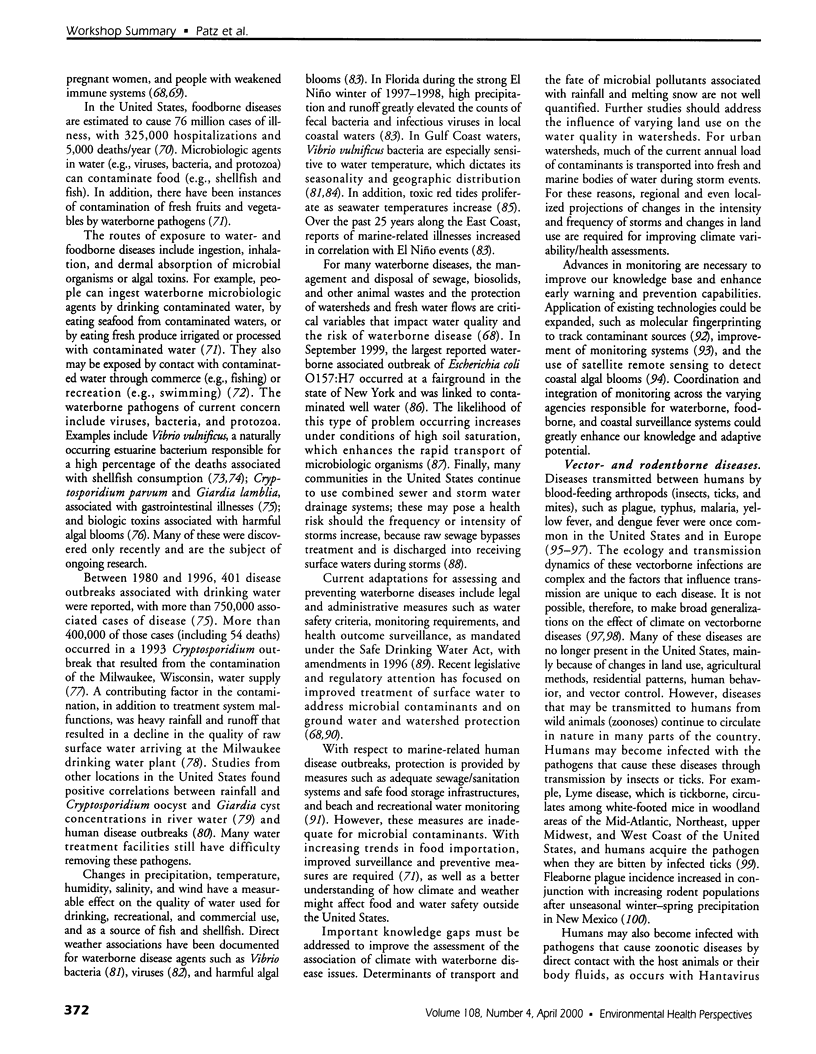
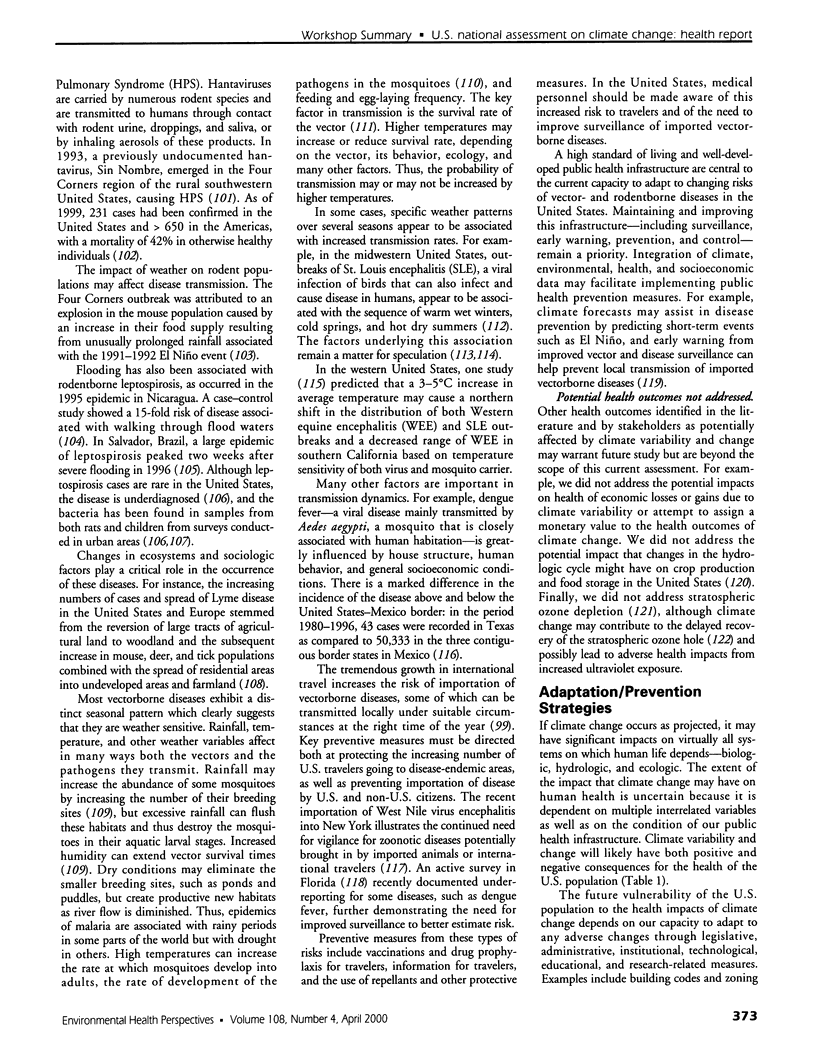
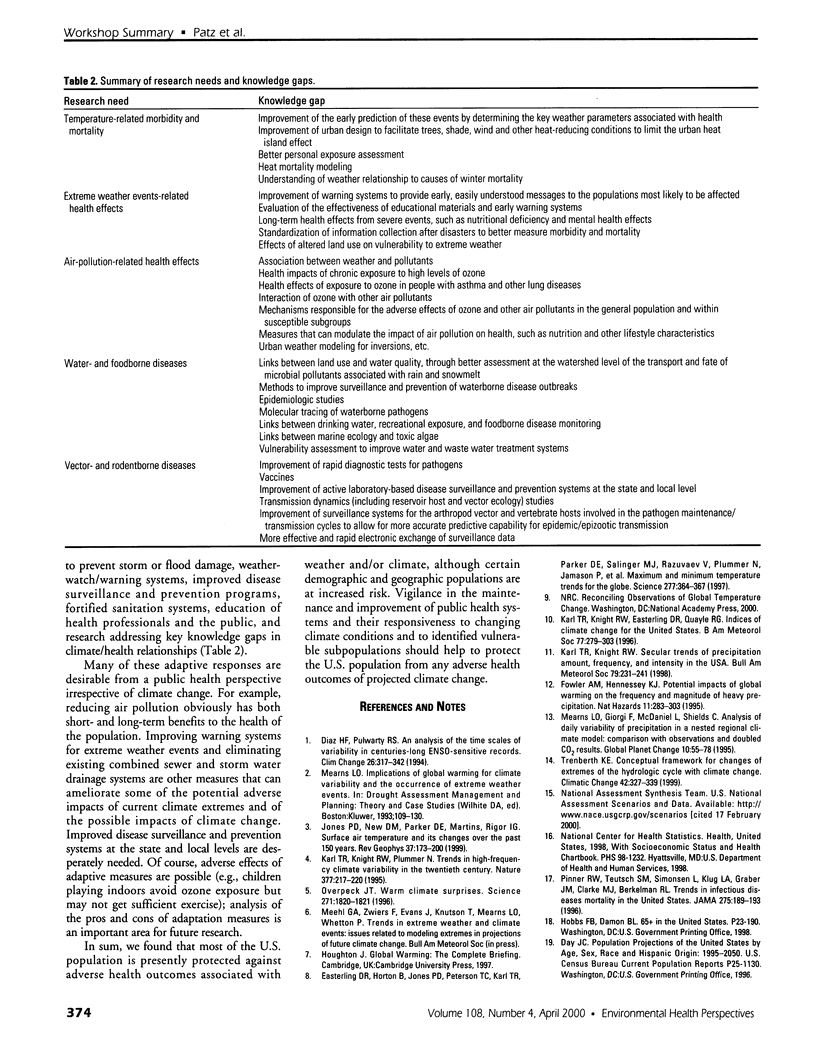
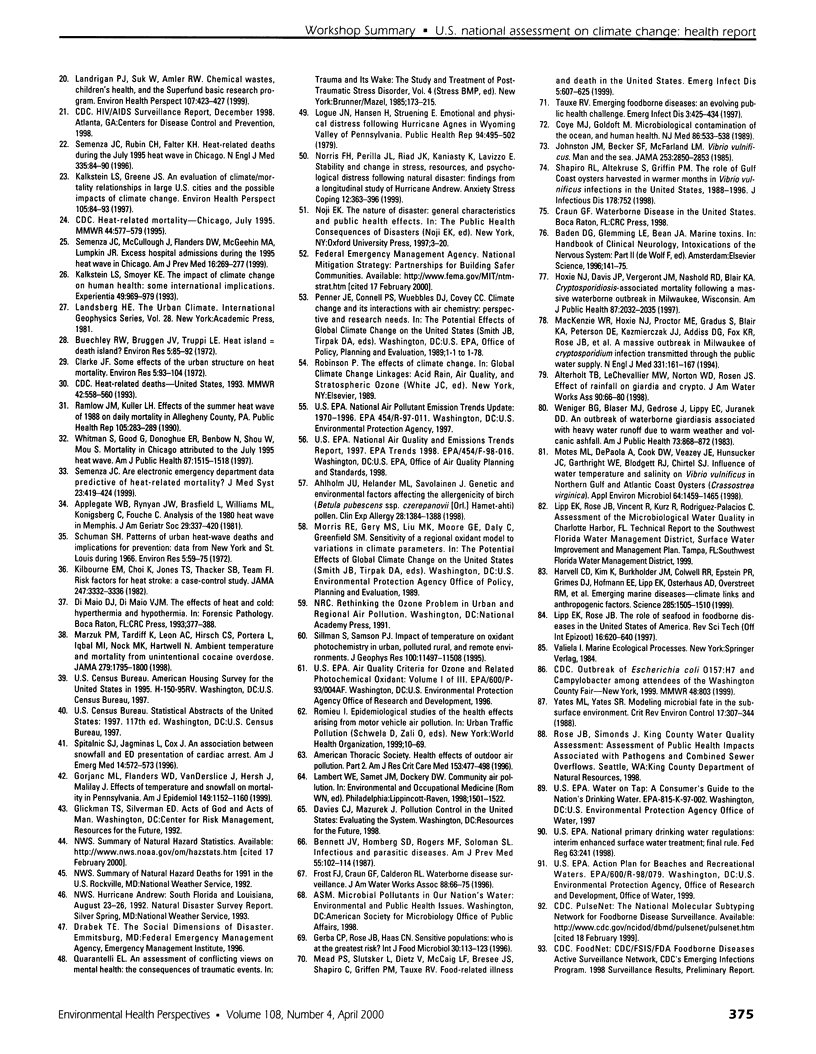

Selected References
These references are in PubMed. This may not be the complete list of references from this article.
- Ahlholm J. U., Helander M. L., Savolainen J. Genetic and environmental factors affecting the allergenicity of birch (Betula pubescens ssp. czerepanovii [Orl.] Hämet-ahti) pollen. Clin Exp Allergy. 1998 Nov;28(11):1384–1388. doi: 10.1046/j.1365-2222.1998.00404.x. [DOI] [PubMed] [Google Scholar]
- Applegate W. B., Runyan J. W., Jr, Brasfield L., Williams M. L., Konigsberg C., Fouche C. Analysis of the 1980 heat wave in Memphis. J Am Geriatr Soc. 1981 Aug;29(8):337–342. doi: 10.1111/j.1532-5415.1981.tb01238.x. [DOI] [PubMed] [Google Scholar]
- Buechley R. W., Van Bruggen J., Truppi L. E. Heat island equals death island? Environ Res. 1972 Mar;5(1):85–92. doi: 10.1016/0013-9351(72)90022-9. [DOI] [PubMed] [Google Scholar]
- Childs J. E., Schwartz B. S., Ksiazek T. G., Graham R. R., LeDuc J. W., Glass G. E. Risk factors associated with antibodies to leptospires in inner-city residents of Baltimore: a protective role for cats. Am J Public Health. 1992 Apr;82(4):597–599. doi: 10.2105/ajph.82.4.597. [DOI] [PMC free article] [PubMed] [Google Scholar]
- Clarke J. F. Some effects of the urban structure on heat mortality. Environ Res. 1972 Mar;5(1):93–104. doi: 10.1016/0013-9351(72)90023-0. [DOI] [PubMed] [Google Scholar]
- Coye M. J., Goldoft M. Microbiological contamination of the ocean, and human health. N J Med. 1989 Jul;86(7):533–538. [PubMed] [Google Scholar]
- Demers R. Y., Thiermann A., Demers P., Frank R. Exposure to Leptospira icterohaemorrhagiae in inner-city and suburban children: a serologic comparison. J Fam Pract. 1983 Dec;17(6):1007–1011. [PubMed] [Google Scholar]
- Engelthaler D. M., Mosley D. G., Cheek J. E., Levy C. E., Komatsu K. K., Ettestad P., Davis T., Tanda D. T., Miller L., Frampton J. W. Climatic and environmental patterns associated with hantavirus pulmonary syndrome, Four Corners region, United States. Emerg Infect Dis. 1999 Jan-Feb;5(1):87–94. doi: 10.3201/eid0501.990110. [DOI] [PMC free article] [PubMed] [Google Scholar]
- Gerba C. P., Rose J. B., Haas C. N. Sensitive populations: who is at the greatest risk? Int J Food Microbiol. 1996 Jun;30(1-2):113–123. doi: 10.1016/0168-1605(96)00996-8. [DOI] [PubMed] [Google Scholar]
- Gill J., Stark L. M., Clark G. G. Dengue surveillance in Florida, 1997-98. Emerg Infect Dis. 2000 Jan-Feb;6(1):30–35. doi: 10.3201/eid0601.000105. [DOI] [PMC free article] [PubMed] [Google Scholar]
- Gorjanc M. L., Flanders W. D., VanDerslice J., Hersh J., Malilay J. Effects of temperature and snowfall on mortality in Pennsylvania. Am J Epidemiol. 1999 Jun 15;149(12):1152–1160. doi: 10.1093/oxfordjournals.aje.a009770. [DOI] [PubMed] [Google Scholar]
- Gubler D. J. Resurgent vector-borne diseases as a global health problem. Emerg Infect Dis. 1998 Jul-Sep;4(3):442–450. doi: 10.3201/eid0403.980326. [DOI] [PMC free article] [PubMed] [Google Scholar]
- Harvell C. D., Kim K., Burkholder J. M., Colwell R. R., Epstein P. R., Grimes D. J., Hofmann E. E., Lipp E. K., Osterhaus A. D., Overstreet R. M. Emerging marine diseases--climate links and anthropogenic factors. Science. 1999 Sep 3;285(5433):1505–1510. doi: 10.1126/science.285.5433.1505. [DOI] [PubMed] [Google Scholar]
- Hoxie N. J., Davis J. P., Vergeront J. M., Nashold R. D., Blair K. A. Cryptosporidiosis-associated mortality following a massive waterborne outbreak in Milwaukee, Wisconsin. Am J Public Health. 1997 Dec;87(12):2032–2035. doi: 10.2105/ajph.87.12.2032. [DOI] [PMC free article] [PubMed] [Google Scholar]
- Johnston J. M., Becker S. F., McFarland L. M. Vibrio vulnificus. Man and the sea. JAMA. 1985 May 17;253(19):2850–2853. doi: 10.1001/jama.253.19.2850. [DOI] [PubMed] [Google Scholar]
- Kalkstein L. S., Greene J. S. An evaluation of climate/mortality relationships in large U.S. cities and the possible impacts of a climate change. Environ Health Perspect. 1997 Jan;105(1):84–93. doi: 10.1289/ehp.9710584. [DOI] [PMC free article] [PubMed] [Google Scholar]
- Kalkstein L. S., Smoyer K. E. The impact of climate change on human health: some international implications. Experientia. 1993 Nov 15;49(11):969–979. doi: 10.1007/BF02125644. [DOI] [PubMed] [Google Scholar]
- Kilbourne E. M., Choi K., Jones T. S., Thacker S. B. Risk factors for heatstroke. A case-control study. JAMA. 1982 Jun 25;247(24):3332–3336. [PubMed] [Google Scholar]
- Ko A. I., Galvão Reis M., Ribeiro Dourado C. M., Johnson W. D., Jr, Riley L. W. Urban epidemic of severe leptospirosis in Brazil. Salvador Leptospirosis Study Group. Lancet. 1999 Sep 4;354(9181):820–825. doi: 10.1016/s0140-6736(99)80012-9. [DOI] [PubMed] [Google Scholar]
- Lanciotti R. S., Roehrig J. T., Deubel V., Smith J., Parker M., Steele K., Crise B., Volpe K. E., Crabtree M. B., Scherret J. H. Origin of the West Nile virus responsible for an outbreak of encephalitis in the northeastern United States. Science. 1999 Dec 17;286(5448):2333–2337. doi: 10.1126/science.286.5448.2333. [DOI] [PubMed] [Google Scholar]
- Landrigan P. J., Suk W. A., Amler R. W. Chemical wastes, children's health, and the Superfund Basic Research Program. Environ Health Perspect. 1999 Jun;107(6):423–427. doi: 10.1289/ehp.99107423. [DOI] [PMC free article] [PubMed] [Google Scholar]
- Lipp E. K., Rose J. B. The role of seafood in foodborne diseases in the United States of America. Rev Sci Tech. 1997 Aug;16(2):620–640. doi: 10.20506/rst.16.2.1048. [DOI] [PubMed] [Google Scholar]
- Logue J. N., Hansen H., Struening E. Emotional and physical distress following Hurricane Agnes in Wyoming Valley of Pennsylvania. Public Health Rep. 1979 Nov-Dec;94(6):495–502. [PMC free article] [PubMed] [Google Scholar]
- Mac Kenzie W. R., Hoxie N. J., Proctor M. E., Gradus M. S., Blair K. A., Peterson D. E., Kazmierczak J. J., Addiss D. G., Fox K. R., Rose J. B. A massive outbreak in Milwaukee of cryptosporidium infection transmitted through the public water supply. N Engl J Med. 1994 Jul 21;331(3):161–167. doi: 10.1056/NEJM199407213310304. [DOI] [PubMed] [Google Scholar]
- Marzuk P. M., Tardiff K., Leon A. C., Hirsch C. S., Portera L., Iqbal M. I., Nock M. K., Hartwell N. Ambient temperature and mortality from unintentional cocaine overdose. JAMA. 1998 Jun 10;279(22):1795–1800. doi: 10.1001/jama.279.22.1795. [DOI] [PubMed] [Google Scholar]
- McKenzie R., Connor B., Bodeker G. Increased summertime UV radiation in New Zealand in response to ozone loss. Science. 1999 Sep 10;285(5434):1709–1711. doi: 10.1126/science.285.5434.1709. [DOI] [PubMed] [Google Scholar]
- Mead P. S., Slutsker L., Dietz V., McCaig L. F., Bresee J. S., Shapiro C., Griffin P. M., Tauxe R. V. Food-related illness and death in the United States. Emerg Infect Dis. 1999 Sep-Oct;5(5):607–625. doi: 10.3201/eid0505.990502. [DOI] [PMC free article] [PubMed] [Google Scholar]
- Motes M. L., DePaola A., Cook D. W., Veazey J. E., Hunsucker J. C., Garthright W. E., Blodgett R. J., Chirtel S. J. Influence of water temperature and salinity on Vibrio vulnificus in Northern Gulf and Atlantic Coast oysters (Crassostrea virginica). Appl Environ Microbiol. 1998 Apr;64(4):1459–1465. doi: 10.1128/aem.64.4.1459-1465.1998. [DOI] [PMC free article] [PubMed] [Google Scholar]
- Pinner R. W., Teutsch S. M., Simonsen L., Klug L. A., Graber J. M., Clarke M. J., Berkelman R. L. Trends in infectious diseases mortality in the United States. JAMA. 1996 Jan 17;275(3):189–193. [PubMed] [Google Scholar]
- REEVES W. C., HAMMON W. M., LONGSHORE W. A., Jr, McCLURE H. E., GEIB A. F. Epidemiology of the arthropod-borne viral encephalitides in Kern County, California, 1943-1952. Publ Public Health Univ Calif. 1962 Jun 6;4:1–257. [PubMed] [Google Scholar]
- Ramlow J. M., Kuller L. H. Effects of the summer heat wave of 1988 on daily mortality in Allegheny County, PA. Public Health Rep. 1990 May-Jun;105(3):283–289. [PMC free article] [PubMed] [Google Scholar]
- Reeves W. C., Hardy J. L., Reisen W. K., Milby M. M. Potential effect of global warming on mosquito-borne arboviruses. J Med Entomol. 1994 May;31(3):323–332. doi: 10.1093/jmedent/31.3.323. [DOI] [PubMed] [Google Scholar]
- Reisen W. K., Lothrop H. D., Hardy J. L. Bionomics of Culex tarsalis (Diptera: Culicidae) in relation to arbovirus transmission in southeastern California. J Med Entomol. 1995 May;32(3):316–327. doi: 10.1093/jmedent/32.3.316. [DOI] [PubMed] [Google Scholar]
- Reiter P. From Shakespeare to Defoe: malaria in England in the Little Ice Age. Emerg Infect Dis. 2000 Jan-Feb;6(1):1–11. doi: 10.3201/eid0601.000101. [DOI] [PMC free article] [PubMed] [Google Scholar]
- Reiter P. Global warming and mosquito-borne disease in USA. Lancet. 1996 Aug 31;348(9027):622–622. doi: 10.1016/S0140-6736(05)64844-1. [DOI] [PubMed] [Google Scholar]
- Schmaljohn C., Hjelle B. Hantaviruses: a global disease problem. Emerg Infect Dis. 1997 Apr-Jun;3(2):95–104. doi: 10.3201/eid0302.970202. [DOI] [PMC free article] [PubMed] [Google Scholar]
- Schuman S. H. Patterns of urban heat-wave deaths and implications for prevention: data from New York and St. Louis during July, 1966. Environ Res. 1972 Mar;5(1):59–75. doi: 10.1016/0013-9351(72)90020-5. [DOI] [PubMed] [Google Scholar]
- Semenza J. C. Are electronic emergency department data predictive of heat-related mortality? J Med Syst. 1999 Oct;23(5):419-21, 423-4. doi: 10.1023/a:1020537519231. [DOI] [PubMed] [Google Scholar]
- Semenza J. C., McCullough J. E., Flanders W. D., McGeehin M. A., Lumpkin J. R. Excess hospital admissions during the July 1995 heat wave in Chicago. Am J Prev Med. 1999 May;16(4):269–277. doi: 10.1016/s0749-3797(99)00025-2. [DOI] [PubMed] [Google Scholar]
- Semenza J. C., Rubin C. H., Falter K. H., Selanikio J. D., Flanders W. D., Howe H. L., Wilhelm J. L. Heat-related deaths during the July 1995 heat wave in Chicago. N Engl J Med. 1996 Jul 11;335(2):84–90. doi: 10.1056/NEJM199607113350203. [DOI] [PubMed] [Google Scholar]
- Shapiro R. L., Altekruse S., Hutwagner L., Bishop R., Hammond R., Wilson S., Ray B., Thompson S., Tauxe R. V., Griffin P. M. The role of Gulf Coast oysters harvested in warmer months in Vibrio vulnificus infections in the United States, 1988-1996. Vibrio Working Group. J Infect Dis. 1998 Sep;178(3):752–759. doi: 10.1086/515367. [DOI] [PubMed] [Google Scholar]
- Spitalnic S. J., Jagminas L., Cox J. An association between snowfall and ED presentation of cardiac arrest. Am J Emerg Med. 1996 Oct;14(6):572–573. doi: 10.1016/S0735-6757(96)90102-3. [DOI] [PubMed] [Google Scholar]
- Tauxe R. V. Emerging foodborne diseases: an evolving public health challenge. Emerg Infect Dis. 1997 Oct-Dec;3(4):425–434. doi: 10.3201/eid0304.970403. [DOI] [PMC free article] [PubMed] [Google Scholar]
- Trevejo R. T., Rigau-Pérez J. G., Ashford D. A., McClure E. M., Jarquín-González C., Amador J. J., de los Reyes J. O., Gonzalez A., Zaki S. R., Shieh W. J. Epidemic leptospirosis associated with pulmonary hemorrhage-Nicaragua, 1995. J Infect Dis. 1998 Nov;178(5):1457–1463. doi: 10.1086/314424. [DOI] [PubMed] [Google Scholar]
- Watts D. M., Burke D. S., Harrison B. A., Whitmire R. E., Nisalak A. Effect of temperature on the vector efficiency of Aedes aegypti for dengue 2 virus. Am J Trop Med Hyg. 1987 Jan;36(1):143–152. doi: 10.4269/ajtmh.1987.36.143. [DOI] [PubMed] [Google Scholar]
- Weniger B. G., Blaser M. J., Gedrose J., Lippy E. C., Juranek D. D. An outbreak of waterborne giardiasis associated with heavy water runoff due to warm weather and volcanic ashfall. Am J Public Health. 1983 Aug;73(8):868–872. doi: 10.2105/ajph.73.8.868. [DOI] [PMC free article] [PubMed] [Google Scholar]
- Whitman S., Good G., Donoghue E. R., Benbow N., Shou W., Mou S. Mortality in Chicago attributed to the July 1995 heat wave. Am J Public Health. 1997 Sep;87(9):1515–1518. doi: 10.2105/ajph.87.9.1515. [DOI] [PMC free article] [PubMed] [Google Scholar]


